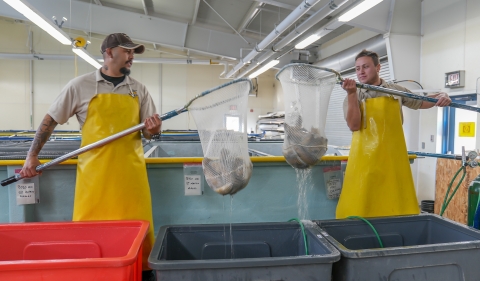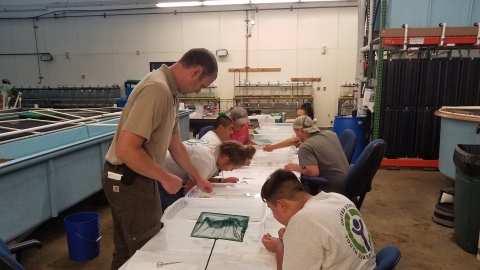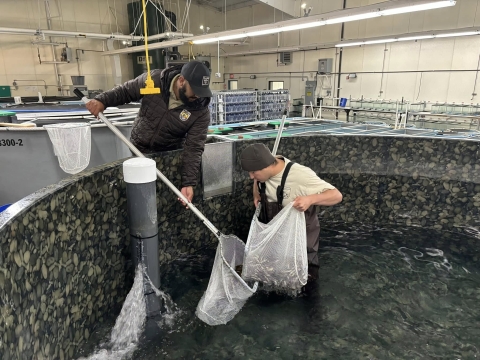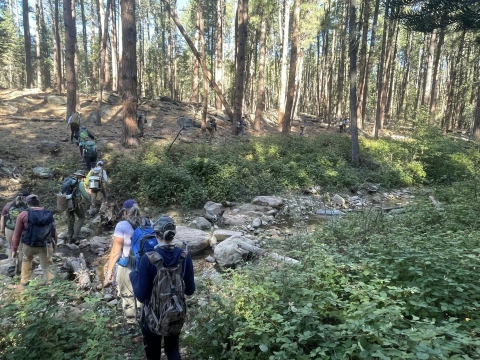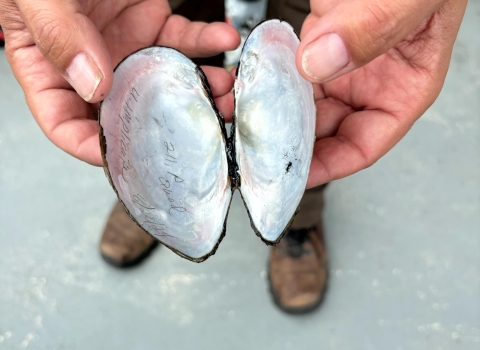Mora National Fish Hatchery in New Mexico is the only hatchery in the world dedicated to raising the threatened Gila trout (Oncorhynchus gilae) for recovery and conservation purposes. Surrounded by ponderosa pines, the hatchery sits at 7,200 feet within the eastern end of the Sangre de Cristo Mountains. At this elevated site, the rare mountain stream fish is bred and raised with the hopes that one day, the Gila trout may once again thrive throughout its historic waters. The hatchery is a recognized leader in environmental achievement with a deep commitment to innovation and stewardship. In recent years, it has achieved major results in bringing this conservation vision to fruition thanks to its passionate local team.
“The facility is checked daily by hatchery staff and is monitored 24/7 by our complex monitoring and alarm systems. The fish need to be cared for and fed daily and the water quality such as, dissolved oxygen, total gas pressure, temperature, flow, etc. need monitoring,” said Daniel Gallegos, project leader at Mora National Fish Hatchery. “In all my combined 10 years here, there's not been one day where somebody has not reported in for duty, seven days a week.”
Local People Helping to Save a Local Species
Gallegos started his career at Mora National Fish Hatchery as a Youth Conservation Corps intern over ten years ago in June 2012. He continued to work there as a pathways intern while attending college and then was hired as a fish biologist at the facility after graduating. After two years at Mora, Gallegos left to work at other federal hatcheries. He returned in February 2023 as the new project leader, guiding and mentoring his team of upwards of 13 people. This number fluctuates during the year because the hatchery hires students and interns.
“This is my hometown, and I am the first local project leader in the history of this facility,” said Gallegos. “This was my career goal, and then on top of that, we're having all this phenomenal success.”
The sense of pride runs deep with the staff at Mora. With only a handful of native trout found in both New Mexico and Arizona, it has been an all-hands-on-deck effort to conserve the Gila trout. Found only in the upper headwaters of the Gila River in New Mexico and Arizona, the striking Gila trout is often described as having taken its coloration from New Mexican sunsets. The fish is iridescent and golden-bodied with small, dark spots that concentrate above its lateral line.
The Gila trout was listed as endangered under the precursor to the Endangered Species Act in 1966 and again in 1973. Then, in 2006, the Gila trout was downlisted from endangered to threatened due to recovery efforts. The reclassification allows recreational fishing in specific areas within New Mexico and Arizona. Mora National Fish Hatchery raises and stocks a large percentage of the Gila trout anglers will find in waterways across the Gila River.
A Reel Dedicated Team
As with many recovery efforts for threatened and endangered species, the hatchery has faced its challenges. The hatchery had historically experienced low eye-up rate (viable fertilized fish eggs) and survival rates for the Gila trout. Recent procedural changes, spawned from updated scientific techniques, experimentation, collaboration and even infrastructure changes (such as upgraded plumbing, new tanks installed, and upgrades to the reuse systems), ensured drastic positive outcomes. Those involved approached the challenge with open minds and a willingness to accept setbacks.
“You cannot be afraid of change,” said Gallegos. “Do you have something? Let's try it, and if it works out, it's phenomenal. I give the team all the credit.”
Mora National Fish Hatchery had a historical average eye-up rate of 20 percent for the Gila trout. This was concerning. “Every year you produce fish, you might think it was a great year, but, in my opinion, the way you measure success at a fish hatchery is by crunching the numbers and calculating percent eye-up and percent of on station survival,” said Gallegos. “There's something going on. We need to figure it out and then work towards implementing new science and new changes to our spawning protocol.”
Gallegos encourages his team to bring solutions to him. Brandon Maes, a fish biologist at Mora National Fish Hatchery, literally did just that when he suggested using a different egg fertilizing solution for the Gila trout and a new method to treat eggs while they are incubating. “Anything is as complicated as you make it out to be, whether it involves implementing new techniques or going back to the basics,” said Maes. “However, perfection is the result of all the small steps done right. There is always room for improvement, and we strive for just that.”
These suggested changes proposed by Maes, along with the new spawning techniques Gallegos proposed, proved to yield higher success rates. After implementing the updated spawning protocols, the eye-up rate increased to an average of 70 percent in 2023 and 86 percent in 2024. In fact, some eye-up rates were as high as 98 percent.
Hooked on Success
Overall juvenile fish survival from 2020 to 2022 averaged 16 percent (10 percent in 2022). After implementing new culture techniques and procedures, the survival rate jumped to 85 percent in 2023 and 91 percent in 2024. Now, the hatchery exceeds its stocking requests and has more fish available for recovery and fishing.
“This past year, we hosted 11 interns through different programs,” said Gallegos. “All of the interns have contributed to our success because each of them has helped in one way or another. I can’t stress enough how proud I am of the whole team, the facility, how grateful I am for everybody who came to help, and how proud I am for the great accomplishments and success we have achieved together.”
Partnering Together
Gallegos led the efforts to create the Gila Trout Work Group two years ago to share best practices. This group is a collaboration between Mora National Fish Hatchery and the two state hatcheries that breed and raise Gila trout for sport fishing: Glenwood State Fish Hatchery in New Mexico and Canyon Creek State Fish Hatchery in Arizona. The group exchanges information about annual Gila trout production at their respective stations, including hatchery results, challenges and successes. They want the two other facilities raising Gila trout to achieve the same or exceed results.
“I can’t tell you how many employees and partners that have contributed to the hatchery’s success because there are so many,” said Gallegos. “This not only includes the Service, but other federal agencies, state partners, and volunteers. So many have helped in one way or another.”
In January 2025, the hatchery hosted the second Annual Gila Trout Work Group meeting, which will be in-person this year. There were hatchery updates, discussions about updated protocols and a tour of the facility showing the infrastructure changes such as the plumbing, new tanks, and upgrades to the reuse systems.
Keeping an Eye on Today and Tomorrow
In addition to its primary purpose of supporting the Gila trout recovery program by spawning fish and maintaining future broodstock broodstock
The reproductively mature adults in a population that breed (or spawn) and produce more individuals (offspring or progeny).
Learn more about broodstock , the Mora National Fish Hatchery also works to meet all its recovery stocking goals for partners and provide any surplus fish to New Mexico and Arizona for sport fishing.
“When I first started here, producing 30,000 Gila trout was considered a great year,” said Gallegos. “In 2024, we ended up producing almost 290,000 viable eyed eggs, shipped 130,000 eyed eggs to Canyon Creek State Fish Hatchery, kept and hatched out the remaining 160,000 eyed eggs, and ended up stocking about 112,000 fish for recovery and recreational purposes. This is hands down the best year we have ever had in the entirety of the facility.”
Mora National Fish Hatchery is one of the many federal hatcheries that raise fish to help restore and sustain these populations for the ecosystem and the American people. Because of its incredible efforts, there are more Gila trout stocked in the mountain rivers of New Mexico and Arizona. Not only does this support the recovery of this threatened species, but it also gives the public an even better chance of catching one.
“This is the public's hatchery,” said Gallegos. “We just take care of it, but it's for the public.”


